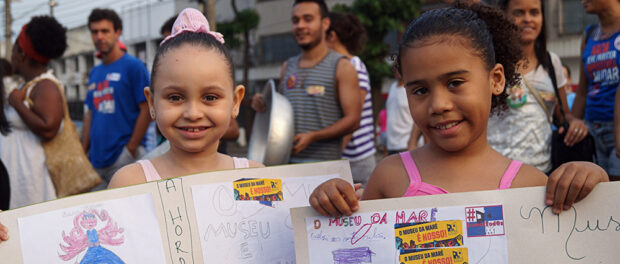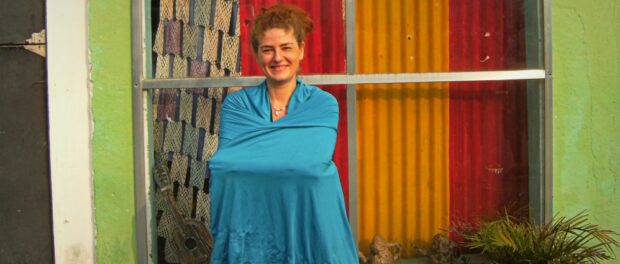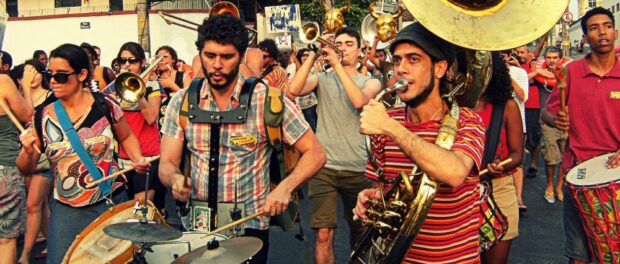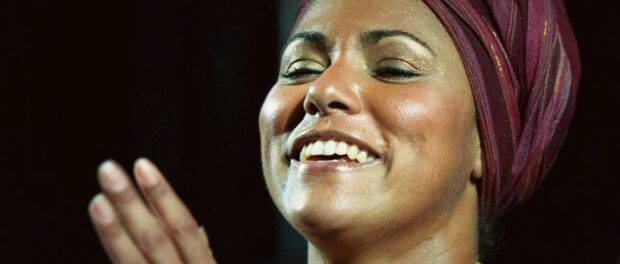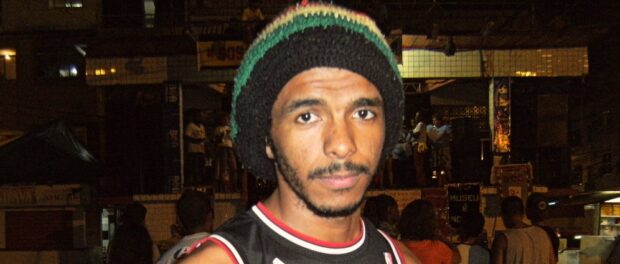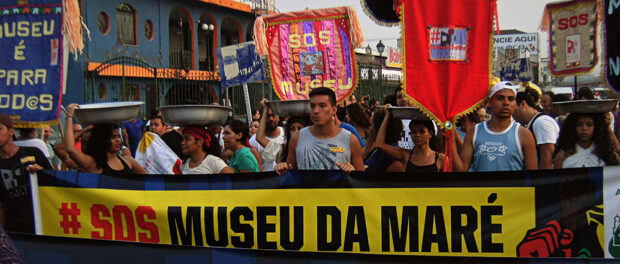
Residents of Complexo da Maré, artists, collaborators and supporters of Museu da Maré marched on Saturday October 18 against the eviction of the museum. Protesters blocked part of the Avenida Brasil highway and voiced their support for the museum with dances, performances, music, and poems.
After seven years providing an acclaimed space for historic preservation, culture and art in Complexo da Maré, Museu da Maré has been threatened with eviction, despite ongoing resistance and thousands of petition signatures.
Global reference, local resistance
The museum’s protest program was planned and promoted during the weeks following the annual “Week of Resistance” event earlier this month. Organizers reached out to residents and artists of the community and elsewhere.
Before the march itself, artists created new works celebrating the museum. At the same time, a publication, Guide to the Media and Human Rights, was launched and debated in the museum’s gallery. As part of the Democratization of Communication in Rio de Janeiro Week, collectives including Coletivo Intervozes (Intervoices Collective), Fórum de Juventudes RJ (Youth Forum Rio de Janeiro) and Fórum de Manguinhos (Manguinhos Forum) supported the museum’s cause.
The march set off at 4 pm on Saturday October 18. The protest welcomed all kinds of artistic expression, from the fanfare band Siderais to the museum’s capoeira group. There were poetry readings, passinho dancing and performances by theater group Grupo Gestos and an intervention Cidades Invisíveis.
Walking alongside cars, armed soldiers and military jeeps–used by the army occupying Complexo da Maré–the march peacefully and loudly reached Parque União square. The microphone was passed to several people who wanted to speak. They made speeches, read texts and sang funk songs recalling past and current fights against favela stigma and human rights violations.
One of the poems referred directly to Libra Group, the company that is threatening the museum with eviction. The poem, by Mario Chagas, suggests that the company doesn’t understand the significance of the museum to the community:
“Time is short
the Libra roars
and the struggle is now
We need to explore
and you can’t explore without memory
the Maré Museum is our ship
of dreams, of desires
of guts, of our futures
with the right to adventure and freedom
Libra doesn’t understand exploring
Libra doesn’t understand memory
Libra doesn’t understand the ship or freedom
Libra (hear our plea)
let the Maré Museum explore in peace”By Mario Chagas, “Museu da Maré livre” (Maré Museum free)
Different voices, same love for Museu da Maré
People of all ages, families, students and artists mixed harmoniously in the event. Although the opinions and origins of the people differed, they all had one thing in common: their love for Museu da Maré.
Elane Povoli, 43, poet and visual artist, working as a civil servant, was one of the artists who created new art during the protest:
“There were objects donated by residents for the construction of the exhibition, but also of use to them in case they needed to borrow them. It’s the effect of art: this appropriation, taking objects out of their daily use and transforming them into works of art.
“Legally this museum has many points in its favor: it’s a project of unquestionable importance, for theoretical and affective underpinnings, for the relation that has been built with the residents. If this were to end, it would be tragic, a murdering of the very population, metaphorically.”
Jiuliano Iris, in art Juvá Piris, 38, member of the fanfare band Siderais, played music during the protest to support the museum:
“My hope is that this space won’t be vacated, or that another place will be given for the museum to keep existing. The State didn’t fulfill its role, meeting people’s needs. And even when it’s a popular initiative, and politicians didn’t have to do anything–they should want to defend this space even more because the work was done already, they don’t have to do anything but defend it.
“I find it very important that these kinds of actions involving collectives get together without politics, but come together mainly for a cause of importance.”
Alexandra Regina Gama, 35, is a Masters student studying Education, Community and Social Movements. She was visiting from Campinas, São Paulo and is a member of Memory Network and Social Museology of São Paulo:
“Being an activist, I’m part of movements like this, and I’ve been thinking a lot about the fragility of spaces of resistance. When a community, an initiative is threatened, the feelings in the extended community are also affected. Civil society has proven that this territory was re-signified, that all the values and relations that the museum has built exceed predictable expectations. This museum is an influence on the local and symbolic belonging of the people that uphold its value [as a space] of culture and companionship.
“[The museum] is reflecting a series of other mobilizations: when a community appropriates its space, its own territory, transforms and gives it value, this calls the attention of the real estate market and other speculators. Other interests start to override work entirely carried out by the community. It’s disproportionate, the weight of an enterprise and the values it brings, over the values of the community. I hope our forces shall prevail–the force of Maré, of Museu da Maré and the people who trust this place to represent us!”
MC PH Lima, 26, is living in São Gonçalo but is originally from Morro da Mineira in Catumbi, Central Rio. He sang an acapella version of his rap “O Bandido do Rio” (The Criminal from Rio) then told us:
“The role of the museum is very important, yet it’s not the first fight here in the favela. In June 2013, for example, more than 10 people were killed and the community staged the exact same protest that the whole of Brazil did. As the song says, ‘In the asphalt (formal city) the bullets are rubber / In the favelas (informal city) the bullets are real.’ Here in Maré the community has always mobilized a lot, including now for the retreat of the army occupying the favela.
“[The museum] is a cultural hub. At the protest, there were various cultural initiatives that were reclaiming the museum, such as capoeira, samba and theatrical representations. They look at the museum as a way of unifying, empowering and fostering culture inside the favela. The baile funk (funk parties) are being repressed, for example. That is a way to keep one’s identity, one’s own roots in the community.
“We have to wield our weapons, which are culture and mobilization: go to the streets and face the government as equals… It’s possible to have rights in the favelas, but for this it is crucial that favelados (favela residents) return to the streets like when Amarildo was killed, when Zezé was killed, for the people to really obtain our rights from the government.”
Legal action
Libra has failed to respond to the voices supporting the museum. Hoping to start a dialogue, the museum and Aderson Bussinger, vice-president of the Brazilian Bar Association’s Rio de Janeiro chapter (OAB-RJ), are preparing legal means of defense.
To view full album see below, or click here to see on Flickr with captions:
Created with Admarket’s flickrSLiDR.

